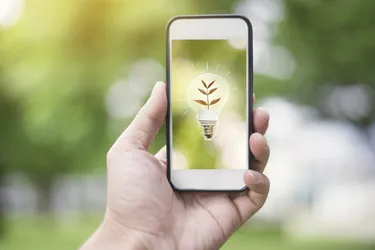How to reduce your phone's power consumption
Smartphones have become an indispensable part of our everyday lives. They help us to stay well informed and connected to friends and acquaintances. But this digital convenience costs a lot of energy. On the one hand, those that the mobile phone consumes itself. For a common device, this is about two to six watts per hour with active use, depending on factors such as display brightness, CPU load and network connection. In stand-by mode, consumption can drop to less than one watt per hour. Over a day, a smartphone can consume about ten to 30 watt hours, depending on the intensity of use. This means that a smartphone consumes about 3.65 to 10.95 kilowatt hours of electricity per year.
On the other hand, smartphones also indirectly consume a lot of energy, which is not required by the use of the devices themselves, but by the transmission of data and its storage in international data centers. This can be changed with a few uncomplicated adjustments to the system settings. This allows you to turn your smartphone into an energy-saving champion in no time at all and reduce the ecological footprint of the device.
1. Turn off GPS, Bluetooth and Wi-Fi as often as possible
Turn off GPS, Bluetooth, and Wi-Fi when you don't need these features. This is because GPS, Bluetooth and Wi-Fi are all continuously searching for signals or networks to connect. When enabled, these features also consume energy in the background, even when not actively used. By turning off these services, the smartphone has to consume less energy in standby mode.
Turning off these features also contributes to the overall efficiency of the smartphone. Less heat is generated, and the processor load is reduced, resulting in improved performance and longevity of the device overall.
2. Improve data protection and minimize tracking
Operating systems such as Android and iOS collect a lot of personal data, which is often used for advertising purposes. By disabling tracking and the advertising identifier, you not only protect your privacy: when these features are disabled, it also reduces the amount of data that needs to be transmitted in the background, which in turn reduces the energy consumption of the device.
3. Optimize apps and system settings
Adjust the settings of your apps so that they consume less energy. For example, disable background updates and location tracking for apps that don't absolutely need these features. Social media apps such as Facebook, Instagram, Twitter and Snapchat, for example, are known for regularly updating data in the background to deliver new content such as messages and notifications.

However, email clients such as Outlook, Gmail and other third-party apps also often check for new emails, which consumes energy in the background. Setting longer intervals between syncs or disabling automatic synchronization can also help save energy. The same goes for weather apps, which update weather data very regularly and use location services to provide local weather information. Here, disabling location tracking or reducing the frequency of updates can help reduce energy consumption.
Changing app settings is usually very easy: Many apps offer specific options to control the frequency of data refresh or to disable background activity altogether.
4. Use energy-saving modes
Many smartphones offer special power-saving modes that, when activated, reduce the performance of the device to save energy. Don't just use these features when the device tells you that the battery level is low.
Good to know: Many smartphones automatically limit background data and processes in energy-saving mode and also reduce screen brightness. Both lead to energy savings.
In the article "Charging mobile phone batteries correctly: Here's how!" you can read how to save your smartphone battery and extend its life.
5. Turn off vibration
Did you know? The vibration function consumes more energy than a ringtone. So turn off the vibration if it is not absolutely necessary.
6. Perform regular software updates
Always keep your device up to date. Software updates often contain important improvements that can optimize the energy consumption of the device. But beware: Updates can sometimes also introduce new features that consume more energy than before. Therefore, you should install updates, but always keep an eye on the respective effects on battery life.

7. Use sustainable apps
Some apps are designed to minimize energy consumption and use resources efficiently. These include, for example, some web browsers that are specifically designed to minimize data consumption and battery usage. Opera Mini, for example, compresses web pages to reduce the amount of data that needs to be transferred. Brave Browser, on the other hand, blocks ads and trackers by default.
Other apps inform users about their energy consumption patterns and give tips on how to reduce energy consumption. Greenify, for example, helps to identify other apps that are draining the battery.
In addition, there are apps that serve to reduce the usage time of the smartphone. The Forest app, for example, promotes concentration and reduces screen time by growing a virtual tree as long as the user is not using the phone. Offtime supports users in minimizing digital distractions and making smartphone use more conscious.
By the way: The mobile phone charger can also help save energy if used correctly. In the article "Standby Power Consumption: Unnoticed Energy Consumption" you will learn why you should unplug chargers when not in use.
source : 7 Tipps, um den Stromverbrauch des Handys zu reduzieren (enercity.de)

Post a Comment for "How to reduce your phone's power consumption"